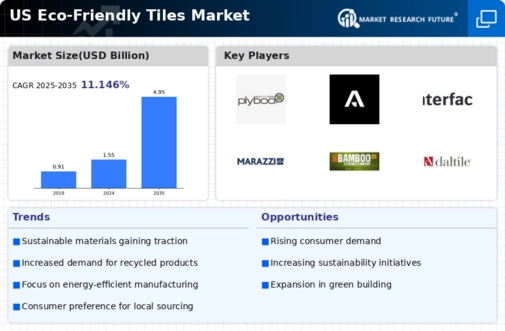Rising Consumer Awareness
The eco-friendly tiles market is experiencing a notable surge in consumer awareness regarding environmental sustainability. As individuals become increasingly informed about the ecological impact of their purchasing decisions, they are more inclined to choose products that align with their values. This shift in consumer behavior is reflected in market data, indicating that approximately 70% of consumers in the US prioritize eco-friendly materials when renovating or building homes. Consequently, manufacturers are responding by expanding their offerings of sustainable tile options, thereby driving growth in the eco friendly-tiles market. This heightened awareness not only influences purchasing patterns but also encourages companies to adopt more sustainable practices in their production processes, further enhancing the appeal of eco friendly tiles in the market.
Growing Demand for Home Renovations
The eco-friendly tiles market is benefiting from a growing demand for home renovations, as homeowners increasingly seek to enhance their living spaces with sustainable materials. Recent surveys indicate that nearly 60% of homeowners in the US are planning renovations that prioritize eco-friendly options. This trend is driven by a desire to improve energy efficiency and reduce environmental impact. As a result, the demand for eco friendly tiles is expected to rise, with many homeowners opting for these materials to achieve their renovation goals. This increasing focus on sustainability in home improvement projects is likely to propel the eco friendly-tiles market forward, as more consumers recognize the long-term benefits of investing in eco-friendly materials.
Architectural Trends Favoring Sustainability
Architectural trends are increasingly favoring sustainability, which significantly impacts the eco-friendly tiles market. Designers and architects are prioritizing eco-friendly materials in their projects, driven by a growing demand for sustainable living spaces. This trend is evident in the rise of green building certifications, such as LEED, which encourage the use of environmentally responsible materials. Recent statistics indicate that buildings certified under LEED standards utilize eco friendly materials at a rate of 40% higher than traditional constructions. As architects continue to advocate for sustainable design, the eco friendly-tiles market is poised to benefit from this shift, as more projects incorporate eco-friendly tiles to meet these evolving standards.
Government Incentives for Sustainable Building
Government incentives play a crucial role in promoting the eco-friendly tiles market. Various federal and state programs offer financial benefits for the use of sustainable building materials, including eco friendly tiles. For instance, tax credits and rebates for energy-efficient home improvements have been shown to increase the adoption of green building practices. Recent data suggests that states with robust incentive programs have seen a 25% increase in the installation of eco friendly materials in residential projects. These incentives not only lower the financial barriers for consumers but also stimulate demand for eco friendly tiles, thereby fostering growth in the market. As more homeowners take advantage of these programs, the eco friendly-tiles market is likely to expand significantly.
Technological Innovations in Material Production
Technological innovations are transforming the production processes within the eco-friendly tiles market. Advances in manufacturing techniques, such as 3D printing and the use of recycled materials, are enabling producers to create tiles that are not only sustainable but also cost-effective. For example, the integration of recycled content in tile production has been shown to reduce material costs by up to 15%, making eco friendly options more accessible to consumers. Furthermore, these innovations enhance the durability and aesthetic appeal of eco friendly tiles, broadening their market appeal. As technology continues to evolve, it is likely that the eco friendly-tiles market will see an influx of new products that meet both consumer demands and environmental standards.























Leave a Comment